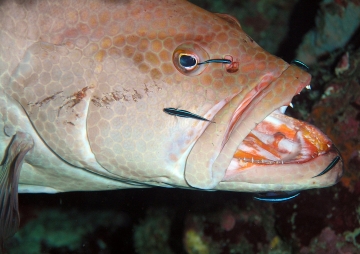SATS print 244_360 px width.jpg

Cleaner gobies (smaller black fish with neon stripes) remove parasites and bacteria from larger fish. Credit: Emma Hickerson, Flower Garden Banks NMS, NOAA
Dental offices and beauty salons follow strict hygiene and sanitation guidelines to prevent the spread of germs among people coming in for a teeth cleaning or eyebrow wax. But the same rules don’t apply to the “beauty salons” and mouth cleaning stations under the sea—and that may be a good thing.
Over 200 different species of fish and over 50 different shrimp species serve the vital role of cleaners to their fellow underwater residents. These cleaner fish often gather in “cleaning stations” on coral reefs where larger fish visit to have parasites and bacteria picked out of their mouths and off their scales. Scientists have known about this for many years, but only recently have they begun exploring what role these cleaning behaviors might play in moving microbes around the reef ecosystem.
To begin understanding this role better, researchers recently studied the impact of the cleaning goby. These fish are only about two inches long and often called neon gobies because their long, slender bodies have an iridescent stripe of color running from their nose to their tail. Scientists removed cleaner gobies from cleaning stations on two reefs off the coasts of Puerto Rico and St. Croix. Then they compared the water nutrients, microbe communities, and fish behavior of these reefs with nearby reefs that still had cleaning gobies. It turned out more fish visited the sites with cleaner gobies, and the variety of both microbes and nutrients differed between the sites.
Further research will help the scientists understand the significance of what they found to the broader health of marine environments, but one thing is clear: cleaner gobies do more than remove bacteria from individual fish. They play a big role in the microbe community of entire reef systems.


